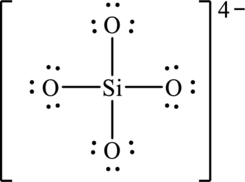
Interpretation:
Lewis structure of orthosilicate anion
Concept Introduction:
Lewis structure represents covalent bonds and describes valence electrons configuration of atoms. The covalent bonds are depicted by lines and unshared electron pairs by pairs of dots. The sequence to write Lewis structure of some molecule is given as follows:
- The central atom is identified and various other atoms are arranged around it. This central atom so chosen is often the least electronegative.
- Total valence electrons are estimated.
- single bond is first placed between each atom pair.
- The electrons left can be allocated as unshared electron pairs or as multiple bonds around
symbol of element to satisfy the octet (or duplet) for each atom. - Add charge on overall structure in case of polyatomic cation or anion.
Hybridization is calculated by the hybrid orbitals and to calculate hybrid orbitals we need to know the steric number that is given by,
The relation of steric number with geometry or shape is depicted in the table below.
Explanation of Solution
The molecule
The symbol for silicon is
The symbol for oxygen is
Four negative charges are added up in the total valence count.
Thus total valence electrons are sum of the valence electrons for each atom in
The skeleton structure
Hence, 24 electrons are allocated as 3 lone pairs on each oxygen atom and total number of electrons about silicon is 8. The Lewis structure of

As from the structure above, there are 4 bond pairs and 0 lone pairs on central atom.
Substitute 4 for number of atoms bonded to central atom and 0 for number of lone pairs on central atom in equation (1) to determine steric number.
The shape of the molecule is defined by the lone pairs present on the central atom. Anion
The formal charges on each atom in Lewis structure can be calculated from the equation as follows:
Here,

Substitute 4 for
Substitute 6 for
Hence formal charge on silicon is 0 and same on each oxygen atom is
Expression to determine oxidation number for
Rearrange equation (3) to determine oxidation number of silicon.
Substitute
The oxidation state of silicon is
Want to see more full solutions like this?
Chapter 3 Solutions
CHEMICAL PRINCIPLES W/SAPLING
- What mass of silver oxide, Ag2I, is required to produce 25g of silver sulfadiazine, AgC10H9N4SO2, from the reaction of silver oxide snd sulfadiazine?arrow_forwardif the radius of a metal element that has an fcc lattice structure is 0.108 nm and weighs 215.7 g/mol, then what is the theoretical density in g/cm^3arrow_forwardHow many valence electrons do you have to account for when drawing the Lewis dot structure of PCl5?arrow_forward
- The common hydrate of magnesium sulfate is heptahydrate, MgSO4∙7H2O. In the crystal structure, how many H2O molecules are likely to be associated with the cation, and how many H2O molecules are likely to be associated with the anion?Explain why.arrow_forwardHow many Mn4 + and O2- ions are in the unit cell of the rutile MnO2?arrow_forwardWrite chemical equations for the following processes: Reduction of VO2+ to produce VO2+ Neutralization of sulfuric acid by barium hydroxide Thermal decomposition of 1 mol of sodium bicarbonate to produce sodium carbonate, carbon dioxide and waterarrow_forward
- Describe the features of Network Covalent Atomic Solids, Carbon and Silicates?arrow_forwardDescribe the role of(i) NaCN in the extraction of gold from gold ore.(it) SiO2 in the extraction of copper from copper matte.(iii) Iodine in the refining of zirconium. Write chemical equations for the involved reactions.arrow_forwardExplain why (I3)+ is bent, but (I3) is linear.arrow_forward
 Chemistry by OpenStax (2015-05-04)ChemistryISBN:9781938168390Author:Klaus Theopold, Richard H Langley, Paul Flowers, William R. Robinson, Mark BlaserPublisher:OpenStax
Chemistry by OpenStax (2015-05-04)ChemistryISBN:9781938168390Author:Klaus Theopold, Richard H Langley, Paul Flowers, William R. Robinson, Mark BlaserPublisher:OpenStax Chemistry: Principles and PracticeChemistryISBN:9780534420123Author:Daniel L. Reger, Scott R. Goode, David W. Ball, Edward MercerPublisher:Cengage Learning
Chemistry: Principles and PracticeChemistryISBN:9780534420123Author:Daniel L. Reger, Scott R. Goode, David W. Ball, Edward MercerPublisher:Cengage Learning Principles of Modern ChemistryChemistryISBN:9781305079113Author:David W. Oxtoby, H. Pat Gillis, Laurie J. ButlerPublisher:Cengage Learning
Principles of Modern ChemistryChemistryISBN:9781305079113Author:David W. Oxtoby, H. Pat Gillis, Laurie J. ButlerPublisher:Cengage Learning Chemistry: The Molecular ScienceChemistryISBN:9781285199047Author:John W. Moore, Conrad L. StanitskiPublisher:Cengage Learning
Chemistry: The Molecular ScienceChemistryISBN:9781285199047Author:John W. Moore, Conrad L. StanitskiPublisher:Cengage Learning



